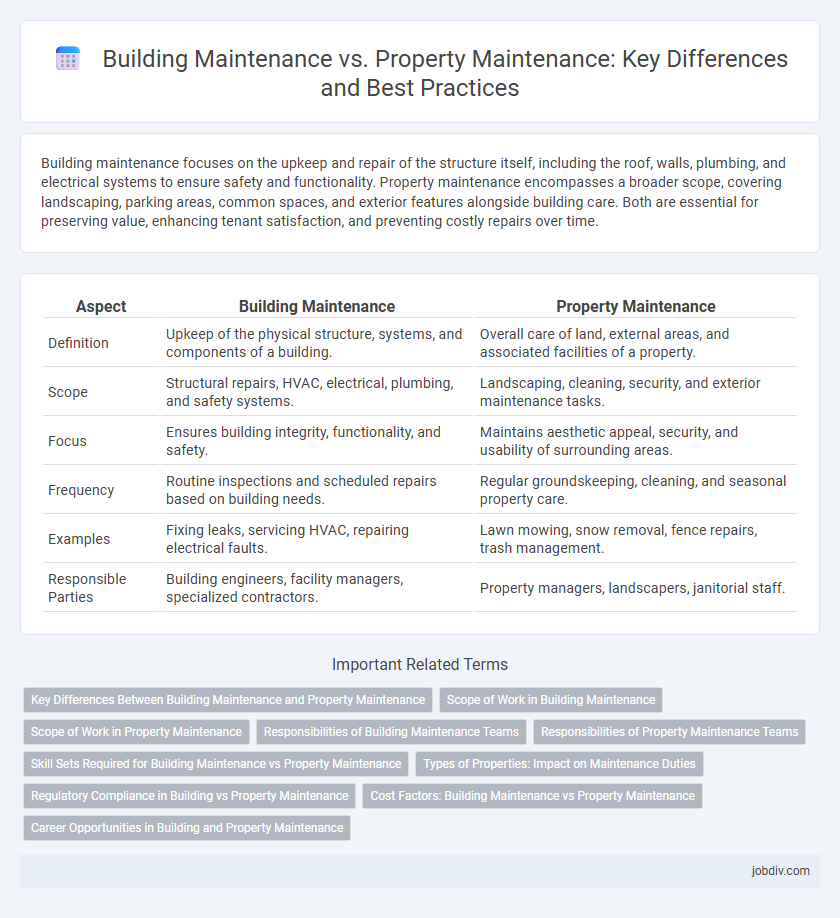Building maintenance focuses on the upkeep and repair of the structure itself, including the roof, walls, plumbing, and electrical systems to ensure safety and functionality. Property maintenance encompasses a broader scope, covering landscaping, parking areas, common spaces, and exterior features alongside building care. Both are essential for preserving value, enhancing tenant satisfaction, and preventing costly repairs over time.
Table of Comparison
| Aspect | Building Maintenance | Property Maintenance |
|---|---|---|
| Definition | Upkeep of the physical structure, systems, and components of a building. | Overall care of land, external areas, and associated facilities of a property. |
| Scope | Structural repairs, HVAC, electrical, plumbing, and safety systems. | Landscaping, cleaning, security, and exterior maintenance tasks. |
| Focus | Ensures building integrity, functionality, and safety. | Maintains aesthetic appeal, security, and usability of surrounding areas. |
| Frequency | Routine inspections and scheduled repairs based on building needs. | Regular groundskeeping, cleaning, and seasonal property care. |
| Examples | Fixing leaks, servicing HVAC, repairing electrical faults. | Lawn mowing, snow removal, fence repairs, trash management. |
| Responsible Parties | Building engineers, facility managers, specialized contractors. | Property managers, landscapers, janitorial staff. |
Key Differences Between Building Maintenance and Property Maintenance
Building maintenance primarily involves the upkeep of structural elements, including HVAC systems, electrical wiring, plumbing, and roofing to ensure the safety and functionality of the physical building. Property maintenance encompasses a broader scope, addressing external areas such as landscaping, parking lots, sidewalks, and common amenities to enhance curb appeal and tenant satisfaction. Key differences lie in the focus areas: building maintenance targets internal infrastructure, while property maintenance covers exterior grounds and shared community spaces.
Scope of Work in Building Maintenance
Building maintenance primarily focuses on the upkeep and repair of structural elements like walls, roofs, HVAC systems, and electrical wiring to ensure the safety and functionality of the physical building. It includes routine inspections, preventive measures, and corrective repairs tailored to the building's infrastructure and operational systems. Property maintenance encompasses a broader scope, including landscaping, parking areas, and common facilities, but building maintenance zeroes in on preserving the internal and external structural integrity.
Scope of Work in Property Maintenance
Property maintenance encompasses a broader scope of work compared to building maintenance, including upkeep of common areas, landscaping, pest control, and exterior repairs across an entire property or complex. It involves routine inspections, preventive measures, and management of safety compliance for multiple structures and shared amenities. Effective property maintenance ensures operational efficiency, enhances tenant satisfaction, and preserves the overall value of the real estate asset.
Responsibilities of Building Maintenance Teams
Building maintenance teams are responsible for the upkeep and repair of structural elements such as walls, roofs, HVAC systems, and electrical wiring to ensure safety and functionality. Their duties include routine inspections, addressing wear and tear, and coordinating with specialized contractors for complex issues. Efficient building maintenance minimizes downtime, extends the lifespan of assets, and complies with regulatory standards.
Responsibilities of Property Maintenance Teams
Property maintenance teams are responsible for the ongoing care, repair, and upkeep of both the interior and exterior aspects of residential or commercial properties, including landscaping, plumbing, electrical systems, and structural integrity. Their duties extend to routine inspections, addressing tenant requests, and coordinating with specialized contractors for major repairs or renovations. Effective property maintenance ensures safety, enhances property value, and improves tenant satisfaction through prompt resolution of issues and preventative maintenance strategies.
Skill Sets Required for Building Maintenance vs Property Maintenance
Building maintenance requires specialized skills in HVAC systems, electrical work, plumbing, and structural repairs, ensuring the physical infrastructure operates efficiently. Property maintenance emphasizes broader competencies, including groundskeeping, pest control, janitorial services, and tenant relations to uphold overall property value and tenant satisfaction. Both fields demand technical knowledge, but building maintenance prioritizes hands-on repair expertise, while property maintenance integrates facility management and customer service skills.
Types of Properties: Impact on Maintenance Duties
Building maintenance primarily targets the structural components of commercial, residential, and industrial buildings, including roofing, HVAC systems, and electrical wiring, ensuring safety and operational efficiency. Property maintenance encompasses a broader scope, covering not only the building itself but also external elements like landscaping, parking lots, and security systems, which vary significantly between single-family homes, multi-unit apartments, and mixed-use developments. The type of property dictates the complexity and frequency of tasks, with commercial properties demanding more frequent inspections and repairs due to higher foot traffic and regulatory requirements compared to residential properties.
Regulatory Compliance in Building vs Property Maintenance
Building maintenance emphasizes strict adherence to local building codes, fire safety regulations, and structural integrity standards to ensure occupant safety and legal compliance. Property maintenance extends regulatory compliance to include landscaping, waste management, and tenant habitability standards, aligned with municipal ordinances and housing laws. Both require regular inspections and documentation to mitigate liability and avoid penalties from regulatory authorities.
Cost Factors: Building Maintenance vs Property Maintenance
Building maintenance costs primarily involve structural repairs, HVAC system servicing, and compliance with safety regulations, often requiring specialized labor and materials. Property maintenance expenses cover landscaping, common area cleaning, and security services, which vary significantly based on property size and usage. Understanding these distinct cost factors helps optimize budgeting for long-term asset preservation and operational efficiency.
Career Opportunities in Building and Property Maintenance
Building maintenance careers focus on preserving the structural integrity and mechanical systems of residential, commercial, and industrial buildings, offering roles such as facility managers, HVAC technicians, and electricians. Property maintenance careers encompass a broader range of duties including landscaping, security, and general upkeep, providing opportunities for groundskeepers, security personnel, and maintenance supervisors. Both fields demand technical skills, with growing job prospects driven by urban development and increasing emphasis on sustainable property management practices.
Building Maintenance vs Property Maintenance Infographic

 jobdiv.com
jobdiv.com